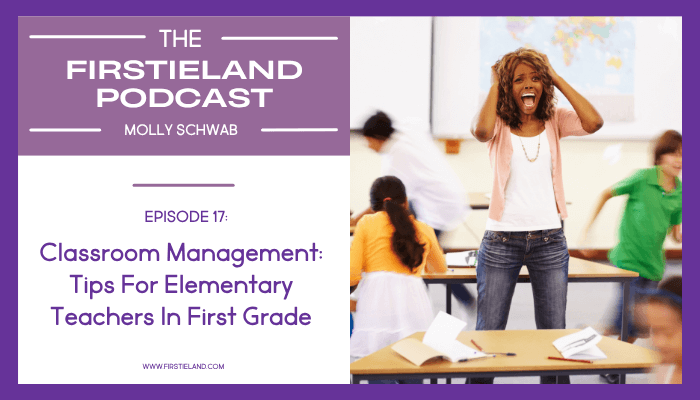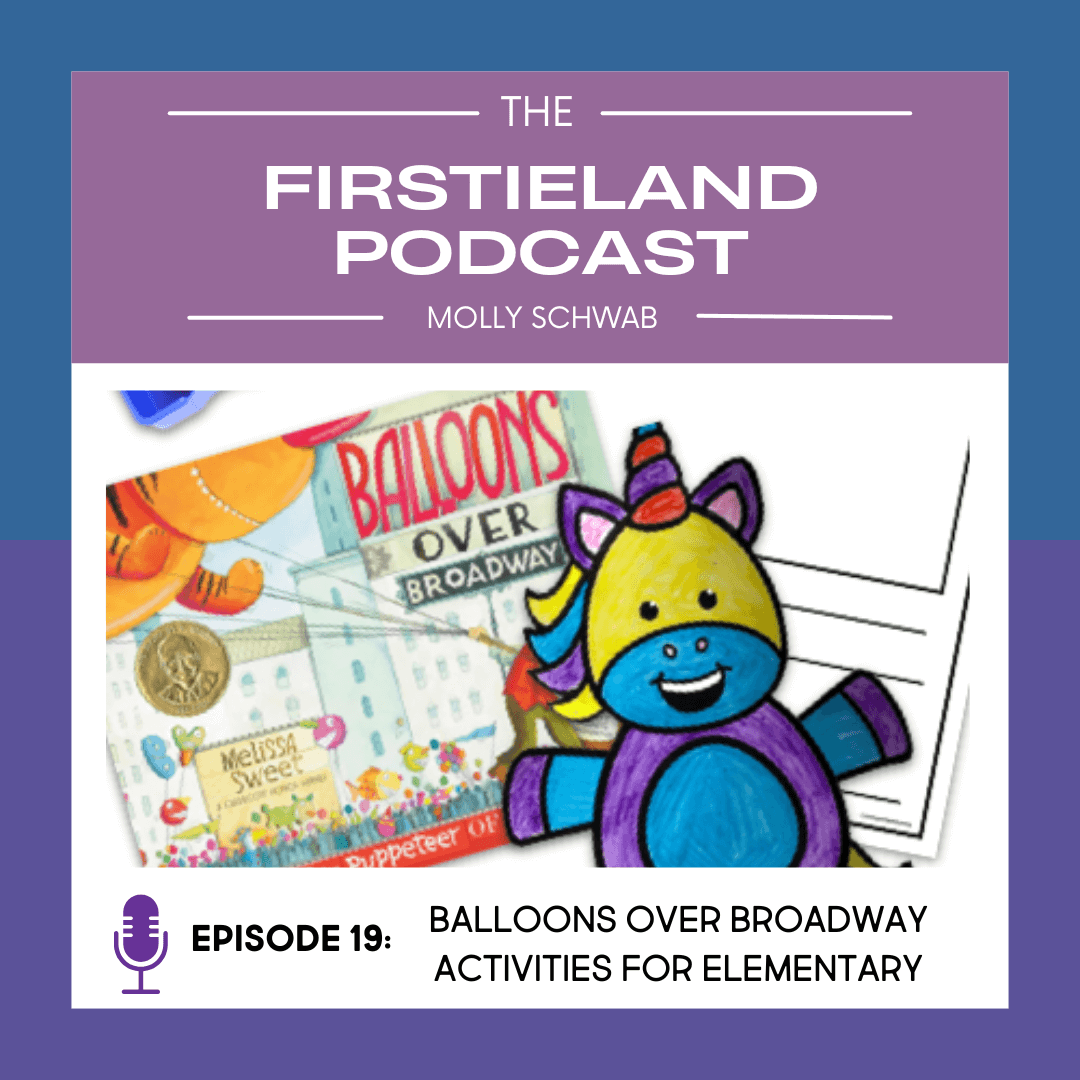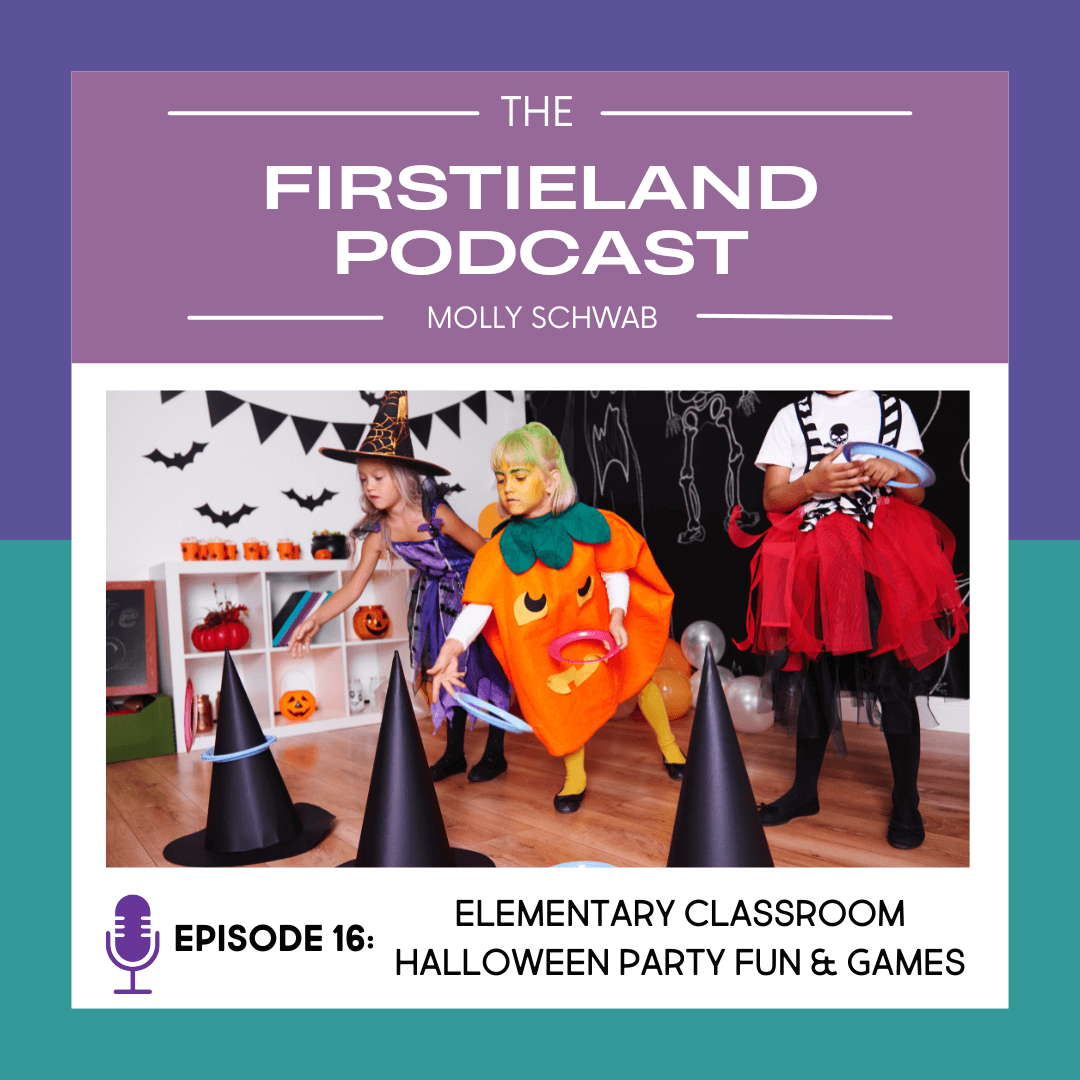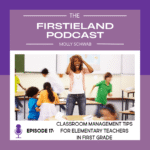[00:00:00] Hey friends. Welcome back to the Firstieland Podcast. I’m your host, Molly Schwab, and you know—you can have the best lesson plans, the cutest classroom, and all the supplies ready to go. But if your students are out of control, none of that matters.
The talking, the fooling around, the constant testing of boundaries—it can leave you feeling exhausted and second-guessing yourself. Today we’re talking about one of the biggest challenges for teachers, which is classroom management. But it doesn’t have to be difficult for you. I’ve got nine tips to help you get your class in line and your classroom management on point. So let’s get started.
Hey there, I’m Molly from Firstieland, a former elementary teacher with over 30 years of experience in kindergarten and first grade. I’m here to help make teaching a little easier and a lot more fun. Whether you’re looking for the perfect read aloud, fresh writing ideas, or simple classroom tips, I’ve got quick [00:01:00] practical strategies you can use right away.
New teacher or experienced educator, there’s something for everyone in Firstieland. So grab your coffee and teacher bag—let’s get started.
All right, so let’s talk a little bit about classroom management. There are so many different schools of thought on this. Some people like whole brain teaching, others like to use things like Class Dojo or clip charts for discipline issues. I’m not here to say that one way is better than the other. You have to choose what works best for you and how you’re going to maintain control of a classroom full of students.
But here’s what I do know: good classroom management is one of the most important skills you need to develop as a teacher. Because given the opportunity, kids will push the limits to find the boundaries in a classroom. They’re gonna talk, fool around, and sometimes be very disrespectful. And so you definitely need to have a plan in place for classroom management.
You know, many kids are new to the school setting, [00:02:00] especially if you’re teaching kindergarten. Some kids have gone to preschool, and if you’re teaching first grade, most kids have at least been to kindergarten. But they’re still learning about school expectations.
Some kids might come from a home where they’re the only child and they’re the first priority all the time. They might be used to being first and always getting their needs met immediately. And then on the other hand, you may have kids who come from homes where they see violent and aggressive behavior.
They might think it’s very normal to hit or yell when they’re upset about something because that’s what they see at home or in their neighborhood. So when all of these kids, who are very different and from very different backgrounds, come together in a classroom, they have to learn how to adapt to a school setting. Kids need to be taught that there are rules, expectations, and consequences for their behavior in school, and they need to learn that this is probably gonna look different than it does at home.
You may have heard the old saying, Don’t let ’em see you smile till Christmas. Some teachers rule with an iron fist with [00:03:00] very little tolerance for misbehavior. Other teachers try to be their students’ best friends with little to no consequences for poor behavior. I personally think that good classroom management lies somewhere in the middle.
As a new teacher or a veteran teacher, you’re gonna need to develop your own classroom management approach that works for you. And I personally think it’s best to start on the very first day of school so that you can set the tone for a smooth year.
So here are a few tips that can help you as you’re trying to develop your own classroom management strategies for your classroom.
Tip number one: Build relationships with your students.
I know you’ve heard teachers say this, and sometimes when you have a really challenging kid, you wanna just shake your head or scream and say, “But you don’t understand! I have this one kid…” and you know—blah, blah, blah. Here’s the thing: in my experience, I’ve found that five-, six-, and seven-year-old kids really want to please you. Some kids may come in all big, bold, and tough on the exterior, but inside they’re still a scared little kid [00:04:00] who wants to feel loved and protected.
And so when you create an environment in your classroom where they know they’re safe—they aren’t gonna get screamed at for every little thing and they aren’t gonna get hit—they will respect you for that. And they will often come around and their behavior will change.
You know, kids like teachers who they think like them. They want to feel loved and cared for and believe that they matter. And so the best way to do that is to build relationships with your students and get to know them.
Find out as much as you can about each kid in your class. Start off by taking a look at their permanent record file. That’s gonna give you a great idea about their family life, their grades, and if they have brothers and sisters. You’re gonna know if there’s a divorce, if there’s a custody battle—all sorts of things.
Another way you can build relationships with your kids is to have parents complete a simple form where they can tell you about their child. Have them list anything their child is afraid of, any special accomplishments they’ve had, if they have any dietary restrictions, [00:05:00] maybe some of their favorite activities they like to do at home, and any other important information. This can really help you get to know your students so that you can begin to develop a relationship with them, and it’ll give you things to talk about with them, too.
I used to have a little page that I sent home with parents at Meet the Teacher Night that said, In a million words or less, tell me everything I should know about your child. Most parents want to brag about their kid and tell you all the great stuff about them. So let ’em! It’s a great way to find out about your students so you can build a better relationship with them.
Tip number two: Use picture books and read-alouds.
Another excellent way to begin to establish expectations in your classroom is through picture books. You can strategically choose books where the characters struggle with different behavior issues that you might see in your classroom. Instead of always yelling at your class, find books that can help you teach about the problem.
It’s a gentler way to approach behavior issues, and kids are more apt to pay attention to a story [00:06:00] than just listen to you getting mad or taking away their recess. When you’re reading the story you can talk about it and say things like, “Gee, have we ever had this happen in our classroom? Why is that a problem? What do you think we can do about it?”
Picture books can really help you establish the behaviors that you want to see in your classroom, and then when they come up again—because they definitely will—you can refer back to the book and say, “Remember when this happened in the story?” and talk about it again.
Because it takes time for behaviors to change. But given time, lots of practice on what they should do, and positive reinforcement when you see good behaviors, you will see changes in your students’ behavior.
I’ll put a link in the show notes to some great books you can read with your class that address common behavior issues.
Tip number three: Create your classroom rules with your students.
When you create your rules together, kids will have more positive classroom behavior. And the reason for this is because if they [00:07:00] help make it, they’ll take more ownership in it.
Take time at the beginning of the school year to develop a list of classroom rules with your students. Use those first few days of school as learning opportunities that you can add to your rules.
For instance, maybe you notice that when you ask kids to line up, they push and shove to be first. That’s a great opportunity to sit together as a class and discuss how you should line up. Talk to the kids about how someone could get hurt and why they should keep their hands to themselves, and then add that to your rules chart.
I do think that when you create your rules, you want them to be overarching rules that can apply to lots of different situations. For instance, instead of a rule that says, “No running in the hallway,” you could make a rule that says, “We will walk inside the building.” That covers classrooms, hallways, the cafeteria, the library—everywhere.
Plus, when you write your rules in more positive language like that, it tells kids what they should do, not what they shouldn’t do.
Tip number four: Model everything.
Kindergarten and first grade [00:08:00] kids are new to school and they need specific instruction and plenty of modeling. When teaching your students your expectations and classroom procedures, show them what you mean.
For instance, if you want kids to push in their chairs when they get up, show them exactly how to do it. Walk over to the kid’s desk, sit down, show them how to stand up, and push the chair all the way under the desk so it doesn’t stick out.
You might think that kind of stuff takes up too much time, but it’s the sort of thing you have to do if you want to have good control and best practices for classroom management.
I think as teachers we sometimes make assumptions that kids know what we mean when we tell them something. For instance, if you say “Line up quietly” and you have a kid run to get in line, or another one who’s whispering to a friend as they’re walking to the line, they might not understand why they got in trouble.
In their mind, the kid who ran is thinking, I was quiet. I didn’t talk to anyone. Or the kid who was whispering is thinking, I was quiet. I was whispering—and that’s quiet.
So when you model your [00:09:00] expectations, kids see exactly what you mean and they understand more. That leads to better behavior in the classroom, and your classroom management is more on point.
So taking the time to model your expectations is never a waste of time. In fact, it’s some of the best time you can spend in your classroom.
Tip number five: Practice makes perfect.
Once you’ve modeled all your procedures and expectations, you have to practice them over and over. Your goal in the first few weeks of school should be to model and practice everything.
It’s important that you don’t skip this step. And if you’re listening to this episode right now in the middle of the year and you didn’t model your expectations at the start of the year, that’s okay. Do it now. You can model what you expect any time of the year because kindergarten and first grade kids need to practice lots of times before it sticks.
No matter what time of the year it is, if your class needs it, take time every day to go over your rules chart and review those expectations.
If you have to, start your day at morning [00:10:00] meeting by reviewing your rules. And some years are like that. Some years, by some miracle, you get a great class with no behavior problems and it’s like you’re in heaven. But in my experience, those years are very few and far between, and there’s usually at least one kid who’s gonna give you a run for your money.
So if you have to, review the rules daily.
Before you begin a new activity, remind kids how that transition should look. For instance, if you’re getting ready to dismiss kids from the carpet to go back to their seats, take a second to remind them and say, “Remember—how do we go back to our seats? We walk silently. Okay, now go ahead and go back to your seats.” Sometimes that’s all it takes to stop a problem before it happens.
And throughout the day, when you see kids who are following the rules or doing something right, praise them out loud. Use it as a reminder for other kids who might be struggling.
Occasionally have those kids model whatever the expectation is for your other students. Or even better, choose the problem [00:11:00] kids to model the correct behavior for the class.
For instance, if you want your class to line up and one kid always runs, before it’s time to line up for lunch one day, ask that kid to show everyone how they should walk to the line. It makes that kid feel special, they don’t get yelled at that day for running, and it reminds them how they should line up. So instead of yelling at that kid to get your point across, do it in a more positive way so you can praise them for doing it right.
If you notice that students aren’t lining up correctly or they’re falling into other bad habits, practice and model again—over and over. Just keep doing it. Not as a punishment, but more as a reminder.
Instead of getting mad at the kids when they run to line up and saying, “Well, now we have to do it all over again!” choose a different approach. Before you have them line up say something like, “Yesterday I noticed that some people were running to line up, so let’s review how to do that again as we line up for lunch today. Red table, please show us how to get in [00:12:00] line.” And then they all walk over and you say, “Great, that’s exactly how it should be done!” and so on with the rest of the class.
The class is still lining up for lunch, it’s not taking any more time than usual, and they’re doing it the right way without any problems.
You might think it’s a waste of time or that you need to get on to more important things. Don’t think that. Take the time to establish your expectations no matter what time of the year it is, and it will really pay off.
Tip number six: Slow down in order to speed up.
And this sort of goes along with practice makes perfect. You know, as you are moving throughout the year, you may notice that new behavior problems start to come up. Maybe those once-perfect kids are starting to get chatty. Maybe you notice kids are off-task and they’re not getting their work done.
Instead of punishing those kids, try to figure out why these behaviors are starting to happen. You may find out that something’s changed at home and that’s bothering the child, or you may simply find out that the material you’re teaching is [00:13:00] starting to get harder.
At a certain point in the year, you may need to slow down a bit in what you’re teaching each day.
Remember that learning new skills day in and day out can be a lot for young kids. Think about the amount of new material they’re getting every single day in every single subject. So instead of pushing through the material just to say you covered it, slow down. Give kids time to practice and review.
Because sometimes kids are just feeling overwhelmed with all the work. Sometimes they just need a break. So give it to ’em. Sometimes that’s all it takes to get those behaviors back in control.
Tip number seven: Use developmentally appropriate practices.
And I know—times are changing and you’re not always given curriculum that is developmentally appropriate. Sometimes you’re encouraged to remove things from your room that your admin may deem more as play and not rigorous for the classroom.
But I am here to tell you that if you are experiencing lots of behavior problems in your classroom and you aren’t giving kids time [00:14:00] to play and be kids—that’s part of the problem.
Be sure that you’re doing lots of hands-on exploration in your kindergarten or first grade classroom. Young kids need to get in there and do things. Too many boring workbook pages and drill-and-skill is gonna make for a boring class that isn’t developmentally appropriate for kids, and they will act out.
Remember, kids learn through play. So give them lots of opportunities to use manipulatives and hands-on materials as often as possible.
Tip number eight: Be prepared.
This one is not so much about classroom management, but more about how to avoid problems. You know that old Boy Scout motto, Always be prepared. Use this in your classroom as well.
Teachers who are prepared with lesson plans written and materials set out and ready to go every morning are gonna have fewer behavior problems in their classroom. And the reason for that is because you aren’t gonna be running around like a [00:15:00] crazy person trying to get ready every morning. You aren’t gonna have to leave your class unattended—which is a big no-no—to run some copies that you forgot about.
You’re gonna be able to stand at the door each morning and greet your students, and that sets the tone for the day. Instead of ignoring them as they walk in because you’re frantically trying to find the read aloud you need for that morning or whatever.
So take the time to write your lesson plans for the week, and have everything ready and organized for each day.
In my room, I had five different colored boxes that were labeled Monday through Friday on a shelf behind my desk. And then I even took it a step further and had a little table in front of my desk where I’d lay out all my activities for that day in the order that we’d be using them.
I know that might sound a little over the top, but I knew right where everything was and I was never searching for something while my class was waiting—because that just leads to trouble and talking and misbehavior.
We could transition from one activity to the next, and the kids never had time to get in trouble because it was all [00:16:00] very smooth and seamless.
Tip number nine: Have a sense of humor.
I mean, if you’re gonna be a teacher you have to learn not to sweat the small stuff. As long as your class is learning and being respectful, try to let the little things roll off your back. Laugh with your kids once in a while and have some fun.
Remember at the beginning I said that kids like teachers who they think like them. So when you can laugh at a little mistake, or give a kid a hug when they screw up and say, “It’s okay, try to do better tomorrow”—they’ll respect you for that and like you for that, and then they will try harder.
You know, it’s not necessary to punish a kid for every little infraction. I’ve seen teachers do that so many times. The first time a kid talks at their table or fools around in line they say, “Go flip a card!” or “You just lost five minutes of recess!” I hated seeing that. It’s not necessary, and honestly, kids hate those teachers, so they have no incentive to try.
It’s okay to remind a kid if they break a [00:17:00] rule and move on. Children don’t have to be disciplined for every little thing. Sometimes all they need is a reminder. Of course, if you have a kid who continues to act out or misbehave daily, then a consequence may be necessary. But sit down with the child and talk to them about it. Ask why they’re acting out. Be a listening ear. Explain that there will be a consequence for their actions, but afterward it’s a clean slate.
Kids know when they’re doing something wrong, and sometimes they just want to see what they can get away with. When you set limits and boundaries, you’re helping kids learn how to control their behavior.
Okay friends, I hope this episode gave you a few good tips and you’re walking away with some ideas you can try this week. I put a free list of classroom routines and expectations you should teach in the show notes, and that will help you figure out exactly where to get started. If you have any special circumstances or concerns and you need help, you can [00:18:00] always send me a DM over on Instagram at @Firstieland. I’m happy to help you brainstorm some solutions.
That’s it for today, and as always, remember to make learning feel like play. See you next week.
Thanks so much for tuning in. I hope you’re walking away with some great tips you can use right away. Be sure to hit the follow or subscribe button so you never miss an episode. And if you’re enjoying the podcast, I’d love it if you’d leave a review. You can find the show notes and links for everything mentioned in this episode at firstieland.com.
I’ll see you next week in Firstieland.










